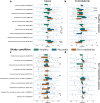Favorable subgingival plaque microbiome shifts are associated with clinical treatment for peri-implant diseases
- PMID: 38374114
- PMCID: PMC10876967
- DOI: 10.1038/s41522-024-00482-z
Favorable subgingival plaque microbiome shifts are associated with clinical treatment for peri-implant diseases
Abstract
We performed a longitudinal shotgun metagenomic investigation of the plaque microbiome associated with peri-implant diseases in a cohort of 91 subjects with 320 quality-controlled metagenomes. Through recently improved taxonomic profiling methods, we identified the most discriminative species between healthy and diseased subjects at baseline, evaluated their change over time, and provided evidence that clinical treatment had a positive effect on plaque microbiome composition in patients affected by mucositis and peri-implantitis.
© 2024. The Author(s).
Conflict of interest statement
P.G., N.S., C.T. and M.B. hold shares in PreBiomics s.r.l., E.P., and D.V. are consultants of PreBiomics s.r.l. M.B. and D.B. are employees of PreBiomics s.r.l. The remaining authors declare no competing interests.
Figures


Similar articles
-
The microbiome of dental and peri-implant subgingival plaque during peri-implant mucositis therapy: A randomized clinical trial.J Clin Periodontol. 2022 Jan;49(1):28-38. doi: 10.1111/jcpe.13566. Epub 2021 Nov 3. J Clin Periodontol. 2022. PMID: 34664294 Free PMC article. Clinical Trial.
-
Intra-oral single-site comparisons of periodontal and peri-implant microbiota in health and disease.Clin Oral Implants Res. 2019 Aug;30(8):760-776. doi: 10.1111/clr.13459. Epub 2019 Jun 5. Clin Oral Implants Res. 2019. PMID: 31102416
-
Pyrosequencing of the subgingival microbiome in peri-implantitis after non-surgical mechanical debridement therapy.J Periodontal Res. 2020 Apr;55(2):238-246. doi: 10.1111/jre.12708. Epub 2019 Nov 2. J Periodontal Res. 2020. PMID: 31677272
-
[Research progress in microbiological characteristics of peri-implant disease].Zhonghua Kou Qiang Yi Xue Za Zhi. 2017 Dec 9;52(12):773-776. doi: 10.3760/cma.j.issn.1002-0098.2017.12.012. Zhonghua Kou Qiang Yi Xue Za Zhi. 2017. PMID: 29275574 Review. Chinese.
-
Primary prevention of peri-implantitis: managing peri-implant mucositis.J Clin Periodontol. 2015 Apr;42 Suppl 16:S152-7. doi: 10.1111/jcpe.12369. J Clin Periodontol. 2015. PMID: 25626479
Cited by
-
Linking peri-implantitis to microbiome changes in affected implants, healthy implants, and saliva: a cross-sectional pilot study.Front Cell Infect Microbiol. 2025 Apr 17;15:1543100. doi: 10.3389/fcimb.2025.1543100. eCollection 2025. Front Cell Infect Microbiol. 2025. PMID: 40313461 Free PMC article.
-
Integrative microbiome- and metatranscriptome-based analyses reveal diagnostic biomarkers for peri-implantitis.NPJ Biofilms Microbiomes. 2025 Aug 26;11(1):175. doi: 10.1038/s41522-025-00807-6. NPJ Biofilms Microbiomes. 2025. PMID: 40858628 Free PMC article.
References
-
- Derks J, Tomasi C. Peri‐implant health and disease. A systematic review of current epidemiology. J. Clin. Periodontol. 2015;16:S158–S171. - PubMed
MeSH terms
LinkOut - more resources
Full Text Sources

